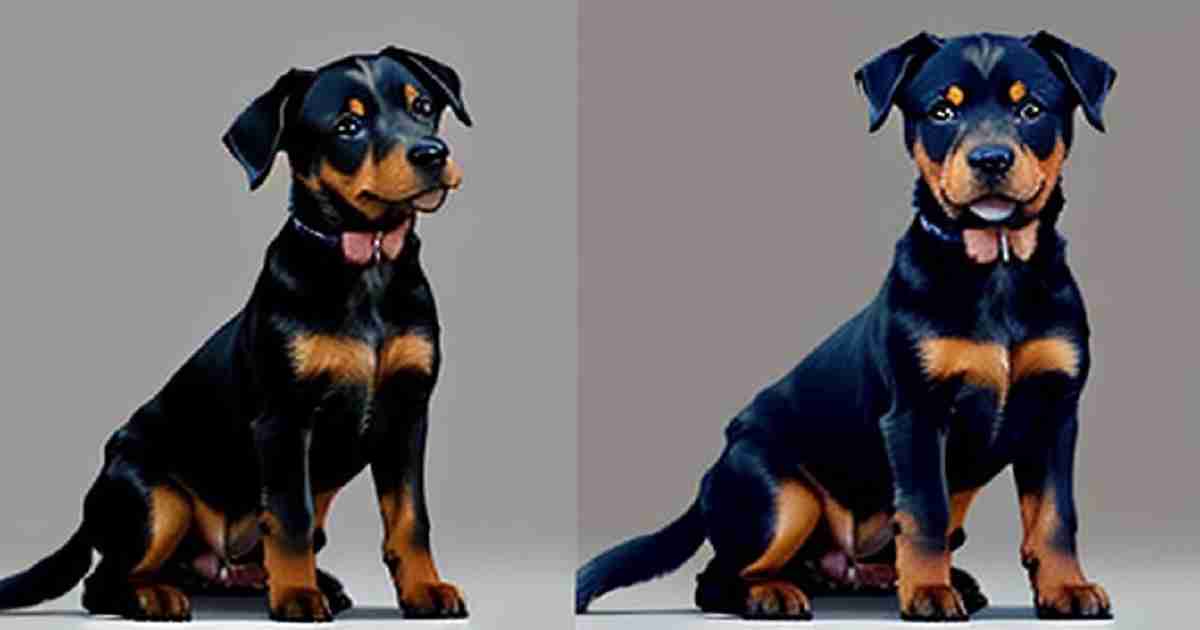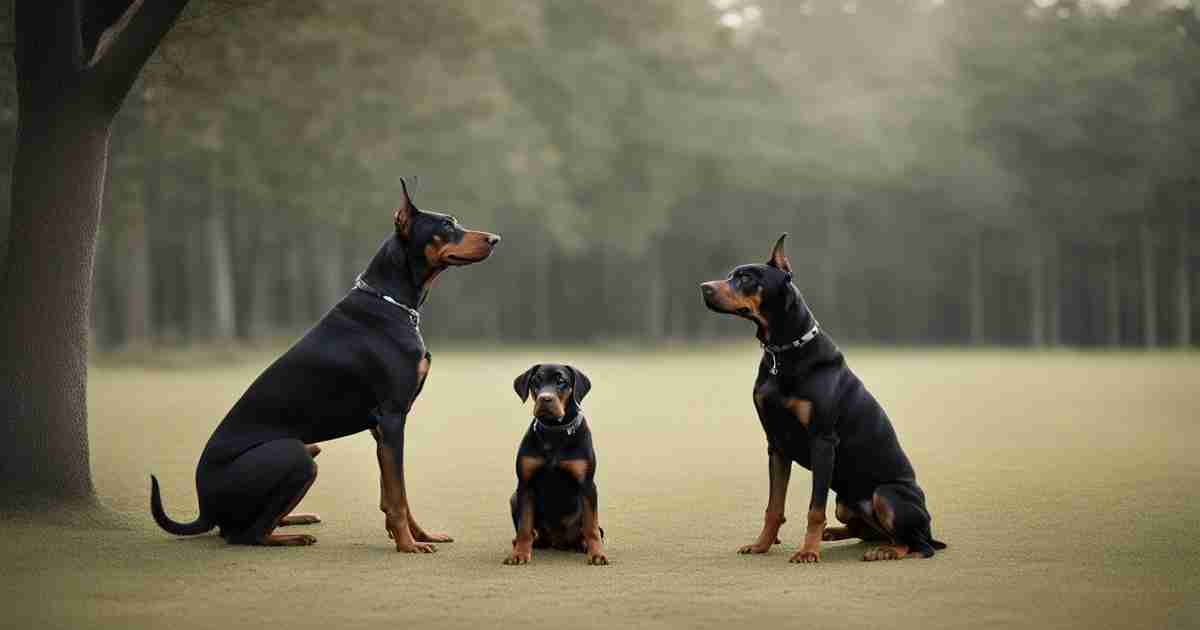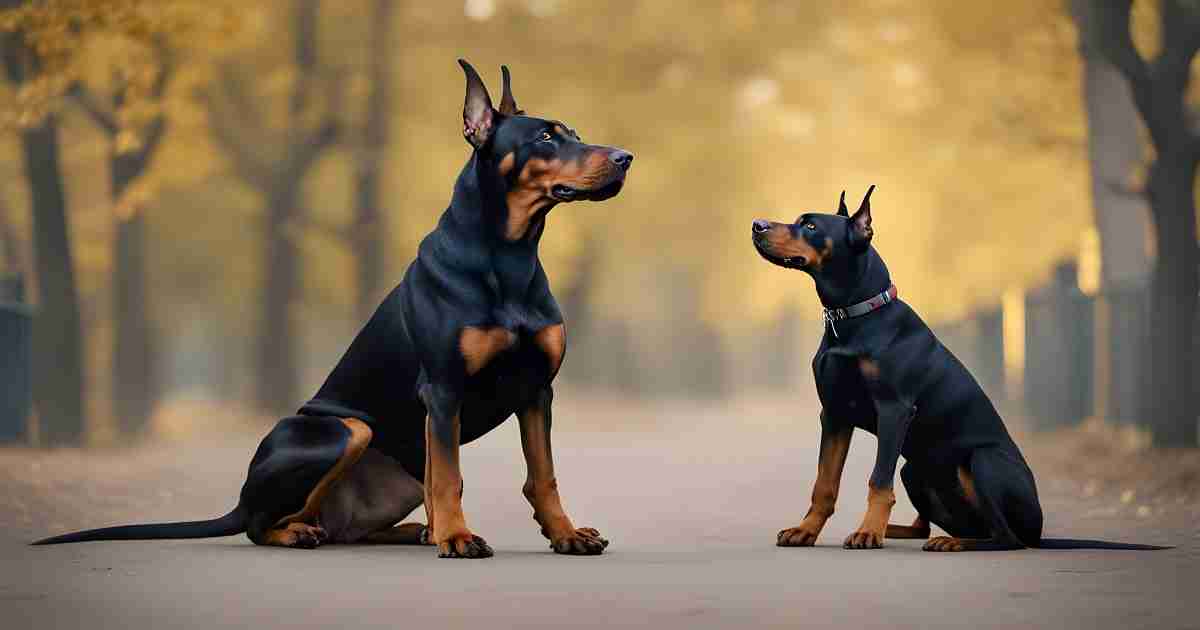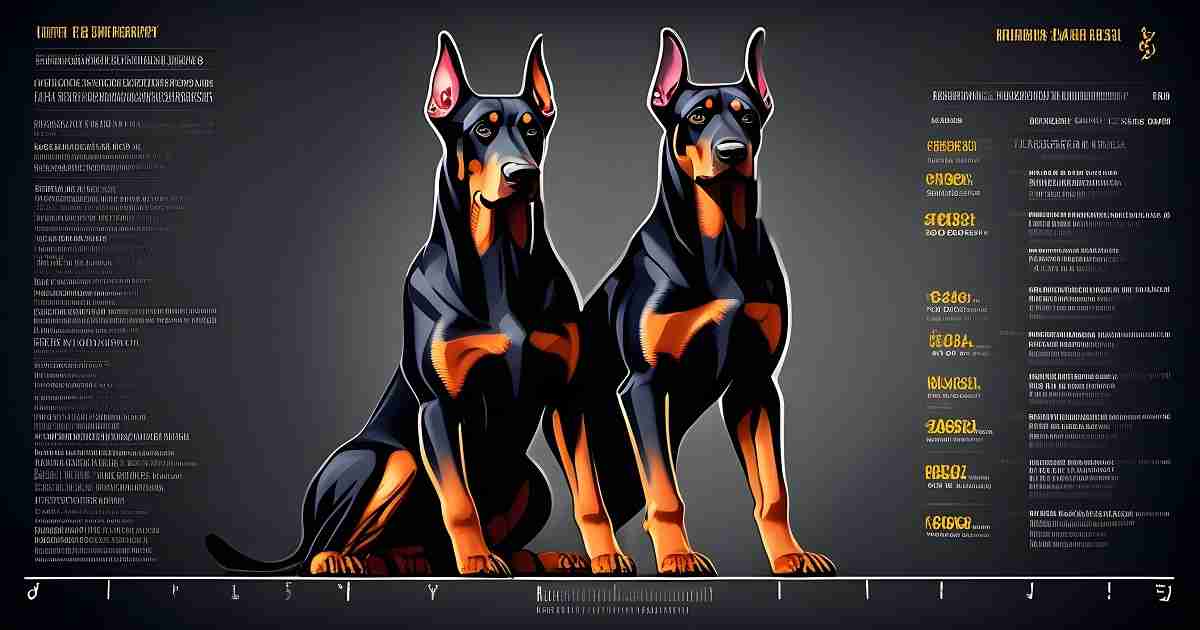As a Rottweiler possessor myself, I’ve always questioned – how my beloved dogs measure up size-wise against different popular breeds like Dobermans.
My Rotts appear so huge and imposing, but can Dobermans deliver them a run for their money within the length branch?
That inquiry launched my complete evaluation of Doberman vs Rottweiler size.
Who comes out on the pinnacle inside the epic war of Doberman vs Rottweiler when searching at height, weight, head proportions, and common frame size?
As fellow fanatics of big dogs know, size goes beyond the numbers – it influences nutrition wishes, exercising requirements, and locating an appropriate domestic.
Via big studies and photographic comparisons, I’ll spoil down the key variations between those large breeds.
I’ll additionally proportion recommendations for Rottweiler owners on properly worrying about your massive-sized puppy. You’ll be surprised to see how near the breeds are in stature!
By way of the end, you’ll have the total scoop on how Dobermans and Rottweilers stack up across all of the key size metrics. Permit’s dive into this ultimate manual to Doberman vs. Rottweiler size!
Average Height of Dobermans vs. Rottweilers
In terms of Doberman vs. Rottweiler size, one of the maximum obvious points of contrast is the peak. Let’s spoil down the typical top range for every breed by gender:
Typical Height Range for Male/Female Dobermans
- Male Dobermans typically stand between:
- 26 to 28 inches tall at the shoulder
- Female Dobermans are generally:
- 24 to 26 inches in height
Doberman height can vary a bit depending on whether the canine is working/show traces or American/European. But on average, they have a tendency to be lean and leggy puppies.
My pal’s Doberman Zeus stands at the higher give-up of the male range – you sense such as you need a stepladder just to puppy him!
Typical Height Range for Male/Female Rottweilers
- Male Rottweilers generally fall between:
- 24 to 27 inches tall
- Females are typically:
- 22 to 25 inches in height
Although shorter than Dobermans on average, Rottweilers make up for it with their stocky frames and thick necks.
My Rottweiler Brutus is on the smaller side for males at 24 inches tall. But at 125 pounds, he’s all brawn and muscle!
Average Weight of Dobermans vs Rottweilers
Moving on to Doberman vs. Rottweiler size in terms of weight, there are noticeable differences between the breeds. Let’s look at the typical weight ranges:
Common Weight Range for Male/Female Dobermans
- Male Dobermans often weigh between:
- 60 to 80 pounds
- Females tend to range from:
- 50 to 70 pounds
Despite their large stature, Dobermans are light on their feet and maintain elegant, athletic frames. Their sleek physiques suit their roles as agile working dogs.
Common Weight Range for Male/Female Rottweilers
- Male Rottweilers typically weigh:
- 95 to 135 pounds
- Females often range between:
- 80 to 100 pounds
Though shorter than Dobermans, Rottweilers are stocky powerhouses who outweigh them significantly. Their substantial bulk matches their strength and guarding abilities.
I don’t know about you, but I was shocked to see Rottweilers outweigh Dobermans by up to 50 pounds! It goes to show you can’t judge a dog’s size at a glance.
Growth Rate Differences Between the Breeds
When comparing Doberman vs. Rottweiler size, it’s important to look at how quickly each breed reaches their full adult stature. There are noticeable differences in their growth patterns from puppyhood to maturity.
Doberman Growth Rate
Doberman puppies grow incredibly fast in their first year, as their long limbs shoot upward rapidly. Here’s a general timeline:
- At 3 months, they’ve achieved about 50% of their adult height. Their gangly legs may seem too big for their body!
- By 6 months, male Dobermans are around 75% of their full height. Females are usually about 68%. Their growth plates are still wide open.
- Most stop growing taller by 12 months, having reached their final frame size by 1 year old.
However, Dobermans continue “filling out” and adding muscle mass until around 18-24 months. So they will keep gaining weight past their first birthday.
Rottweiler Growth Rate
Rottweiler puppies grow at a steadier, more moderate pace than the lanky Dobermans. Their stocky bodies take longer to reach full size. Here’s what to expect:
- At 3 months, Rottweiler puppies have usually reached 30-35% of their adult height. Their solid frames are still quite small.
- By 6 months, males have attained about 50% of their mature height, while females are at 45%. Still lots of room to grow!
- Rottweilers typically stop gaining height by 15 months but may add another 1-2 inches until 18 months.
- They finish filling out their stocky figures in 5-3 years. So Rotties gain significant bulk well into adulthood.
The slower growth period allows Rottweilers’ bones and joints to develop properly as their bodies beef up. Rapid early growth in Dobermans makes them prone to joint issues if not fed carefully.
Key Differences in Growth Patterns
- Dobermans shoot up in height rapidly from 3-12 months reaching their lanky frames fast.
- Rottweilers grow at a steadier pace for 18 months, taking longer to achieve their stocky full size.
- Dobermans gain most of their height first, then fill out with muscle.
- Rottweilers gain height and bulk gradually over 2-3 years.
- The fast growth of Dobermans must be managed carefully to prevent joint issues.
- The slower rate for Rottweilers allows sturdy bone/joint development.
So in comparing the Doberman vs. Rottweiler size growth patterns, Dobermans sprint to their mature heights as gangly pups while Rottweilers take a slower jog to reach their stocky stature. Knowing these differences helps owners provide proper nutrition and exercise at each stage!
Head and Neck Size
When it comes to head size, Dobermans and Rottweilers are kinda like supermodels vs bodybuilders.
Dobies have those sleek, elegant lines with long, wedge-shaped skulls and slim necks. Rotties are stocky powerhouses with massive, broad heads and thick, muscular necks.
Doberman Head
My Doberman Zeus has a head like a refined work of art – slender and streamlined. It matches his tall, lanky body perfectly.
Rottweiler Head
Meanwhile, my Rottweiler Brutus looks like his head was chiseled from a giant block of stone! Short muzzle, pronounced cheeks, and a forehead you could project movies onto. His bull neck is wider than my thigh.
If you placed a Dobie’s head on a Rottie’s body, the dog would just tip over like a bobblehead! And can you imagine a Rottie’s giant noggin on a Dobie’s delicate frame? They’d face-plant in no time.
Key Differences
Clearly, each breed’s distinct head and neck are ideal for their size and abilities. The Dobie’s elegant lines suit their agility and speed. The Rottie’s stocky power is amplified by their massive dimensions.
Beauty comes in many forms – from supermodel to bodybuilder! Both Dobermans and Rottweilers rock their head-size differences with pride.
Body Proportions
When it comes to body types, Dobermans are like gazelles while Rottweilers are like bears!
Doberman Body
- Deep, narrow chest to slice through the air
- Tucked tummy so their legs have room to stretch
- Graceful neck like a prima ballerina
- Lean legs that go on for miles
- Compact, muscular build of an Olympic sprinter
Dobies have the physique of a lightning-fast athlete. They’re built for speed, agility, and mad skills like leaping and zigzagging. My Dobie Zeus could outrun a racehorse!
Rottweiler Body
- Barrel chest you could roll down a hill
- Full belly – no supermodel diets here!
- Thick neck resembling a tree trunk
- Stocky legs sturdy as stone pillars
- Heavy, brawny frame of a wrestling champ
Rotties are shaped like tanks! Their robust structure matches their protective strength and guarding skills. Intruders bounce right off their solid muscles. My Rottie Brutus is a brick house.
Key Differences
- Dobies have tucked waists and leggy frames for agility
- Rotties have stocky legs and thick chests for power
- Dobies have long necks while Rotties have short, thick necks
- Dobies are lean athletes, Rotties are rugged brawlers
So in body types, we’ve got gazelles vs. bears! Dobies were built for aerodynamics, and Rotties were built for brute force. Viva la difference!
Why Size Matters for Dobermans and Rottweilers
Dobermans and Rottweilers are big dogs. I mean really big. Their sheer size is like their superpower. Let’s get approximately why those breeds need their large-than-life dimensions to drag off their puppy responsibilities.
They’re Built to Be Bodyguards
Make no mistake – Dobermans and Rottweilers are intimidating AF. And that’s exactly why we adore them!
Their tremendous bulk allows them to shield and protect their humans. Mess with their circle of relatives, and you’ll discover yourself face-to-face with 100+ pounds of muscular fury. Now not amusing!
However, get this – most of the time, those puppies don’t even need to get physical. Their large size on my own is enough to scare off anyone with bad intentions.
I mean, who’s gonna tangle with a creature that weighs as much as a person and towers over you? These pups are like having your own personal bodyguard, just way cuddlier.
They’re Athletic Superstars
Let’s be honest – with legs like a gazelle and a build like a machine, Dobermans are pure athletes. Their long limbs and lean muscles let them sprint, leap hurdles, and move with cat-like agility. They’re built for speed, endurance, and mad skills.
And Rottweilers? They’re straight-up beastly strong. They have bodies like bulls, all thick and brawny. With their stocky frames, they can pull some serious weight, wrestle with the best of them, and shake off crashes like the Hulk.
Their size gives them the raw power for feats of strength and agility. They’re like canine superheroes!
They Mean Business
Have you seen the head on a Rottweiler? It’s ginormous! And their necks are as thick as tree trunks. Pair that with a Doberman’s sleek power and pointy ears, and you’ve got an imposing duo.
Everything about Dobies and Rotties – from their muscular bulk to their massive heads – just screams:
- Don’t mess with me
- I’m in charge
- I don’t play around
- Fear me if you dare!
This formidable presence lets them excel at guarding and protection roles. After all, their whole job is to look intimidating AF. Size matters when you gotta scare off shady characters!
So next time you see a big, beautiful Rottie or Dobie strutting by, take a moment to appreciate their glorious bigness. Their giant size lets them kick butt at being our loyal defenders and athletic phenoms! We love them just the way they are.
Which Breed Makes a Better Guard Dog?
Dobermans and Rottweilers both kick some serious butt at protection and guard work. But is one breed better suited as a guard dog? Let’s dig into how these pups compare for defending their turf and their people.
They’ve Got Protector Instincts
Guarding is deeply ingrained in both Doberman and Rottweiler’s DNA. After all, it’s kinda their whole purpose for existing! Both breeds will use their massive size and strength to keep their loved ones safe from harm.
Dobies tend to be more agile and energetic with their protection style. They may be rapid on their toes and lightning short to reply to threats. With their size and velocity, they could get the jump on an outsider and take them down.
Rotties are slower and steadier than guardians. They use their bulk and energy to region themselves firmly between danger and their circle of relatives. They’ll hold their ground and won’t budge against an attacker.
No matter their approach, you can count on both breeds to put their life on the line for their people!
They Look Freaking Scary
Here’s the thing – criminals and creeps aren’t likely to stick around and find out how protective a Doberman or Rottweiler really is! Just catching sight of these muscular monsters is enough to send crooks running for the hills.
Their sheer massive size and powerful frames are enough to intimidate any sane person. I mean, who’s going to mess with a creature that weighs more than you do and stands over 2 feet tall? Not me!
Rotties may have a slight edge when it comes to looking intimidating. Their huge blocky heads and thick necks make them look like dinosaurs! Dobies can come across as more elegant which slightly lessens their scare factor.
But make no mistake – no one in their right mind would ever dream of facing off against either of these giants!
They’re Territorial Totally Territorial
Dobies and Rotties were born to patrol and mark their territory. Their guard dog roots run deep! They’ll sound the alarm at the slightest disturbance in their environment to protect their domain.
Rottweilers are more naturally territorial, so they may be quicker to sound the alarm when strangers are near their homes. Dobermans will defend their turf too, but may need more training to hone those territorial instincts.
With proper socialization, both breeds can learn when to tone down their territorial tendencies while still being vigilant watchdogs. But if you’re looking for a dog who’s innately wired to guard their castle, Rotties rule!
The Verdict: Both Breeds Rock at Guarding!
At the end of the day, Dobermans and Rottweilers each have their own strengths that make them phenomenal guard dogs:
- Dobies have speed and agility on their side
- Rotties have sheer bulk and intimidation power
- Both breeds have the protective instincts and smarts for security work
Which is so superior for a guard dog? I’d say it’s a tie! Both Dobermans and Rottweilers will use their enormous size to defend their house and family if given the proper training and socialization.
There isn’t a thief crazy enough to research the potential winner of a Doberman vs. Rottweiler size match!
Health Considerations With Bigger Breeds
Dobermans and Rottweilers are straight-up giants compared to many other dog breeds. And their larger-than-life size comes with some health considerations to keep these pups happy and comfy.
Feeding the Behemoths
In comparison to smaller breeds, Dobermans and Rottweilers are unquestionably enormous. Their enormous frames demand a lot of food!
3–4 cups of kibble are inhaled by a typical Dobie each day. Depending on their massive frame, Rotties devour four to six cups. To feed their enormous frames, we’re talking about pounds and pounds of chow!
In order to maintain their robust muscles and joints and to fuel their active lifestyles, these giants also require certain nutrients.
To keep all that muscular mass, you need to eat high-quality protein. As are calcium and phosphorus, which help create bones.
Feeding the right diet packed with nutrition ensures your Doberman or Rottweiler’s giant body thrives. Otherwise, they may face digestive troubles, bone issues, or excess weight gain on their substantial frames.
Managing Their Monstrous Growth
As we’ve learned, Dobermans and Rottweilers explode into their colossal adult sizes as they mature. But with great growth comes great care!
Excessive exercise, jumping, or poor nutrition during this key period can wreak havoc on still-developing bones and joints. Leggy Dobermans are especially at risk as they erupt upward in height.
Working closely with your vet guarantees your Doberman or Rottweiler grows properly into their behemoth build. Follow exercise limits, feed quality chow, and monitor for problems.
Investing in their development now pays future dividends with a lifetime of mobility and joint health!
The Bloat Beast
Bloat is a terrifying condition that strikes deep-chested giants like Dobermans and Rottweilers. This twisted stomach can kill a dog in hours if untreated.
It happens when their cavernous stomach fills with gas and flips over, trapping the gas inside. This cuts off blood flow and sends them into shock.
Prevent this bloat beast by:
- Feeding multiple smaller meals, not one giant one
- Avoiding intense exercise around mealtime
- Limiting water with meals
Know the signs of bloat like pacing, drooling, retching, and a ballooned belly. Rush to the vet immediately if you suspect this deadly issue! Time is critical.
But understanding the health considerations will help your Doberman or Rottweiler live their very best big dog life! With a little extra attention, they’ll thrive for years to come.
Tips for Caring for Your Big Dog
Dobermans and Rottweilers are giant breeds with giant personalities! Here are some key tips for making sure these big dogs live their very best lives:
Exercise and Playtime Are Musts
With great size comes great energy! Dobies and Rotties need plenty of vigorous exercise and playtime to stay happy and healthy.
Aim for at least 60-90 minutes of activity per day. Go for brisk walks, play high-energy games like fetch, or give them a job to do like agility or obedience work.
Mental stimulation is equally important. Work their brilliant brains with interactive toys, training sessions, or food puzzle games. A bored big dog can get destructive really fast!
Investing in their daily exercise pays off with well-adjusted pups who know how to settle when it’s chill time. A tired Doberman or Rottweiler is a good Doberman or Rottweiler!
Feed the Right Foods
As we covered earlier, these giant breeds need quality nutrition to power their huge bodies. Feed a high-protein diet tailored for large active dogs.
Look for food with glucosamine, chondroitin, and omega fatty acids to support joint health. Calcium and phosphorus levels should be controlled to prevent excess bone growth.
Limit snacking and stick to scheduled meal times to prevent obesity. Two or three meals a day is ideal. Keep water available at all times though!
Consult your vet on the best diet for your Doberman or Rottweiler’s needs. And check out products made specifically for giant or extra-large breeds.
Train Them Right
Dobermans and Rottweilers are super smart! Take advantage of that big brain and train them consistently with positive reinforcement.
Teach and reinforce basic obedience cues like sit, stay, come, down, heel, and leave. This provides mental stimulation plus helps ensure good behavior.
Proper socialization is also essential for these powerful guard dogs. Introduce them to new people, animals, places, and experiences starting as puppies.
This avoids future problems with hostility or overprotective. The correct training method will result in a well-mannered behemoth that strives to please!
Give ‘Em Proper Space
Make sure you have enough space for both inside and outdoor activities because these large men take up a lot of room.
To play and roam freely, they require a yard that is properly fenced. Provide mattresses inside their preferred family hangout areas so that people may relax and take naps.
With their large frames and long legs, they might find it difficult to maneuver around compact automobiles or confined locations. Assist them in avoiding running into things and becoming trapped in comfortable spots!
The Bottom Line
It is true that taking care of a large Doberman or Rottweiler requires more work. But understanding their needs for exercise, diet, training, and space sets them up for a happy life ahead! They’ll reward you with years of goofy giant dog love.
Finding the Right Living Space for a Large Breed
Dobermans and Rottweilers are giant breeds, so it’s critical to discover a domestic with sufficient space for these full-size canines to live simply. Right here are some things to recollect when searching out the appropriate living area for your massive-sized domestic dog.
Yards That Match Their Giant Stature
When reviewing Doberman vs. Rottweiler size, one thing is certain – these big guys need ample outdoor space!
On your house hunt, aim for the most massive fenced backyard possible to contain these towering canines. Athletic Dobies need room to sprint their long legs in Zoomies. Territorial Rotties demand acres to patrol and explore their kingdom. Sturdy fences are a must!
Without a yard, be prepared for marathon walks and daily park trips to satisfy their exercise needs. Watch those giant Rotties strain against their leash, longing to mark their wide domain!
Accommodate Their Mammoth Dimensions
Pay attention to indoor space too for these lumbering beasts. Scanning for tight corners and narrow halls prevents bumped elbows and stubbed toes. Their giant beds must fit comfortably for quality lounging.
Can colossal Rotties wedge their big heads under that eating nook? Standing while chowing that 6-cup dinner can get tiring!
And during indoor playtime, even giant living rooms may not contain their energetic bodies once those fetching skills kick in!
Maneuvering Their Substantial Size
Will rickety stairs withstand their hulking weight? Install ramps for easy access to protect developing joints.
Lifting their burly bulks into vehicles takes serious clearance. Avoid crunched legs and tails with oversized crates for road trips.
Crowded elevators and tiny store aisles? Not ideal for these muscled mammoths. Excellent leash skills are a must to steer through tight spaces.
Homes Suited to Their Grand Statue
The bottom line? Dobermans and Rottweilers demand enough indoor and outdoor space to accommodate their giant frames and endless energy. Size matters – so provide the room they need to live large!
Wrapping Up the Doberman vs Rottweiler Size Debate
Now that we’ve explored Doberman vs. Rottweiler size comparisons from all angles, allow’s recap the important thing variations among these outsized breeds:
Dobermans are tall and lean with tucked waists and long legs built for agility and velocity.
Rottweilers have stocky, muscular builds with extensive chests and enormous bone shapes made for strength.
Dobies attain their lanky full length rapidly in 12-18 months. Rotties take 2-three years to reach their brawny mature shape.
Rottweilers have large, broader heads and thicker necks as compared to the Dobies’ glossy wedge-fashioned heads.
Regardless of their differences, the right training, socialization, nutrition, and workout are vital for both breeds due to their imposing length.
With the proper care, massive Rottweilers make extraordinary companions – loyal, loving, and equipped to have big dog a laugh!
I hope this contrast of Doberman vs. Rottweiler size gave fellow massive canine enthusiasts some beneficial insights! Let me understand which breed’s dimensions you pick.









